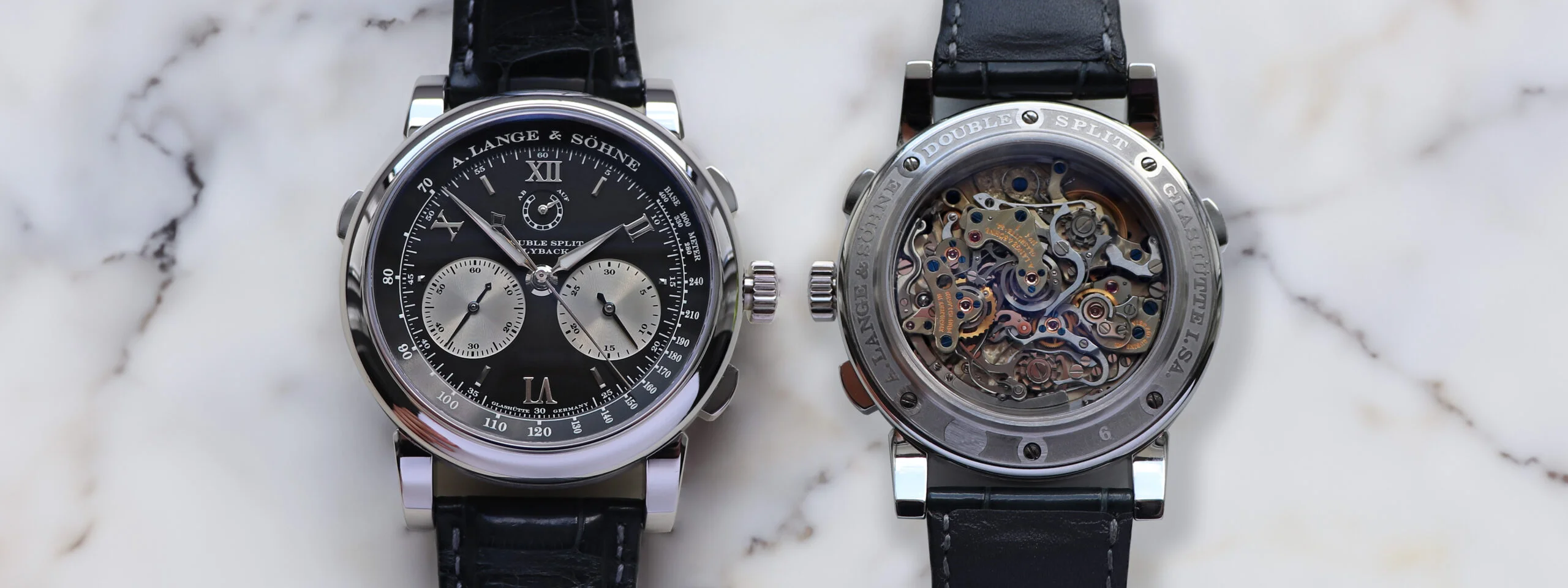
A. Lange & Söhne Double Split
The Collector’s Guide – October 2020. Updated November 2024.
The Blue Ocean Strategy, published by the INSEAD professors Chan Kim and Renée Mauborgne, emphasizes the value innovation – differentiation with low cost to sail into uncharted waters where the innovator becomes the go to address for the newly developed product. It focuses on not to fight on a certain dimension, but rather conquering an area. Although the concept has major flaws in its offering as it seems to be descriptive rather than being prescriptive, I like this highly sticky concept of being the only one in a certain area and try to apply whenever possible. More importantly, I draw great similarities to the subject of the article: Double Split.
Quick Facts:
- Introduced in 2004
- The world’s first Double Rattrapante wristwatch
- Available in platinum, pink gold
- Measures 43.2 mm in diameter and 15.3 mm in thickness
- Received an aesthetic update in 2010
Brief History of Chronograph
In the subsequent century, the chronograph was perfected by watchmaking pioneers like Victorin Piguet. Surprisingly to many, it was Longines in 1913 that first integrated the chronograph mechanism into a wristwatch, using its in-house caliber 13.33Z. This exquisite movement was crafted for the rough and demanding conditions of military use.
Following, Breitling patented the use of separate start, stop, and reset buttons, a significant leap in chronograph functionality. Later, Longines introduced another milestone with the first flyback function in the late 1920s, further advancing the chronograph’s capabilities.
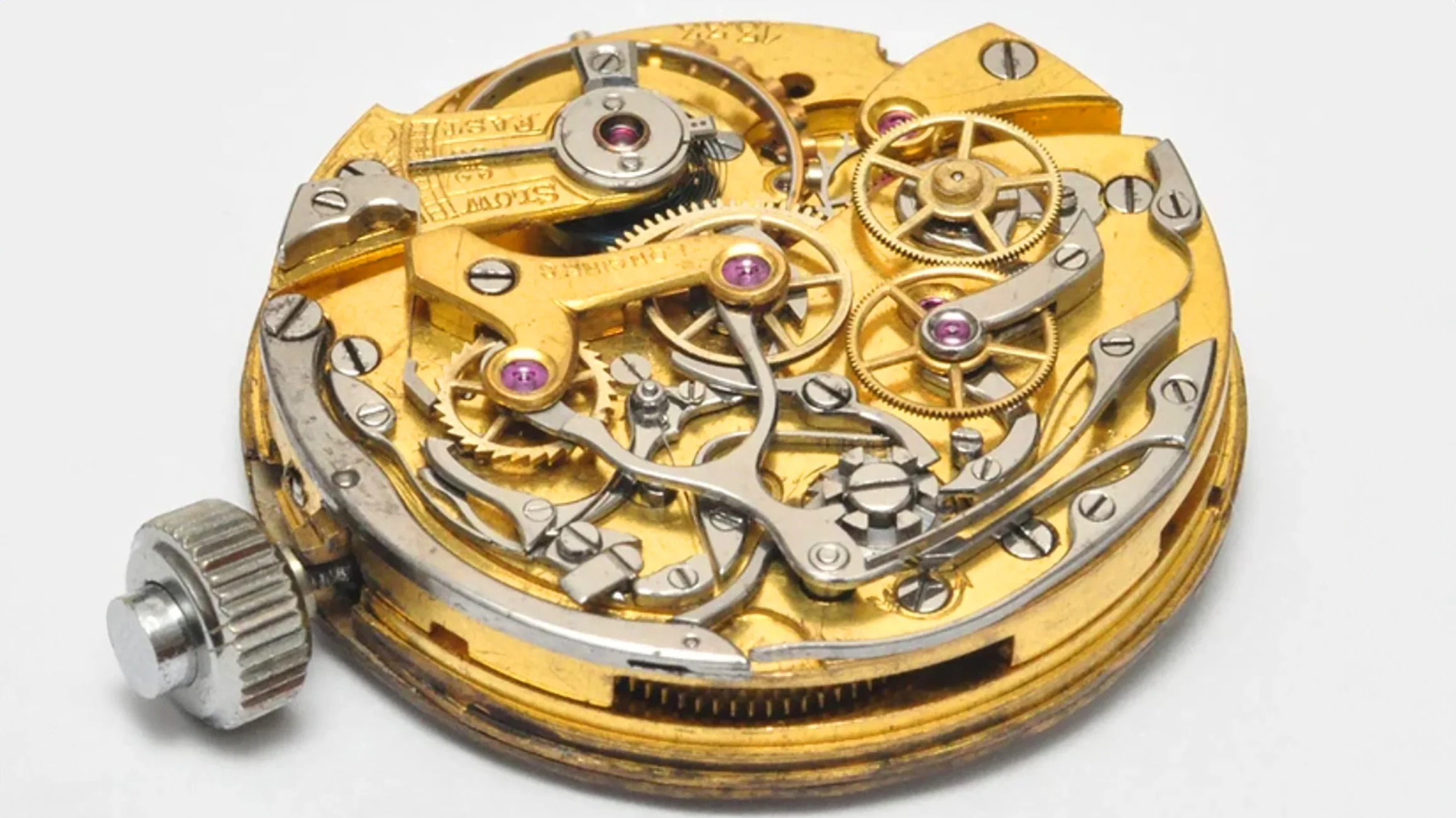
The 13.33z. In terms of overall construction logic, you can see not much has changed since.
However, the quartz crisis of the 1970s forced brands into survival mode, effectively halting research and development in mechanical watchmaking.
After this devastating period, the world had to wait until the late 1990s for a newly developed mechanical chronograph caliber. Enter Blümlein and his team, who seized the opportunity to venture into uncharted territory, kickstarting a new trend: the resurgence of in-house movement development. Just nine years after its revival, A. Lange & Söhne unveiled the caliber L951.1 in the Datograph—a movement many consider the most beautiful chronograph ever made. Its complexity and aesthetic brilliance left the watch world in awe. How could a relatively small German brand achieve such a feat, challenging heavyweights like Patek Philippe, Audemars Piguet, and Vacheron Constantin?
Yet, as we soon discovered, this was just the beginning. Within a few short years, A. Lange & Söhne revealed they had even more ambitious plans to revolutionize the industry.
Double Split Platinum - 2004
Watchmaking is a legacy technology where working with traditional methods is still celebrated,” writes Ryan Rafaelli in his Technology Reemergence article for HBS. Beyond the societal hype and marketing surrounding the industry, certain brands, and specific models, the enduring appeal of watchmaking stems from a fundamental human instinct: the appreciation of art, craft, and nostalgia. While technological advancements—both minor and major—have undoubtedly influenced horology, the fundamental principles underpinning most modern watches, such as the escapement or complications like the chronograph, remain rooted in centuries-old practices.
To stand out in this context, brands occasionally unveil so-called innovations. Unfortunately, many of these fall into the category of marketing gimmicks, contributing neither to a watch’s longevity nor its accuracy. This is somewhat understandable, as modern mechanical watchmaking must operate within the confines of nostalgia and mechanics. Consequently, most innovations in the watch industry are incremental—refining existing concepts rather than reinventing them.
However, within these rigid boundaries, some brands and watchmakers rise above the rest, delivering creations that genuinely push the limits of what is possible. One such example is A. Lange & Söhne’s Double Split, a true testament to extraordinary ingenuity and craftsmanship.
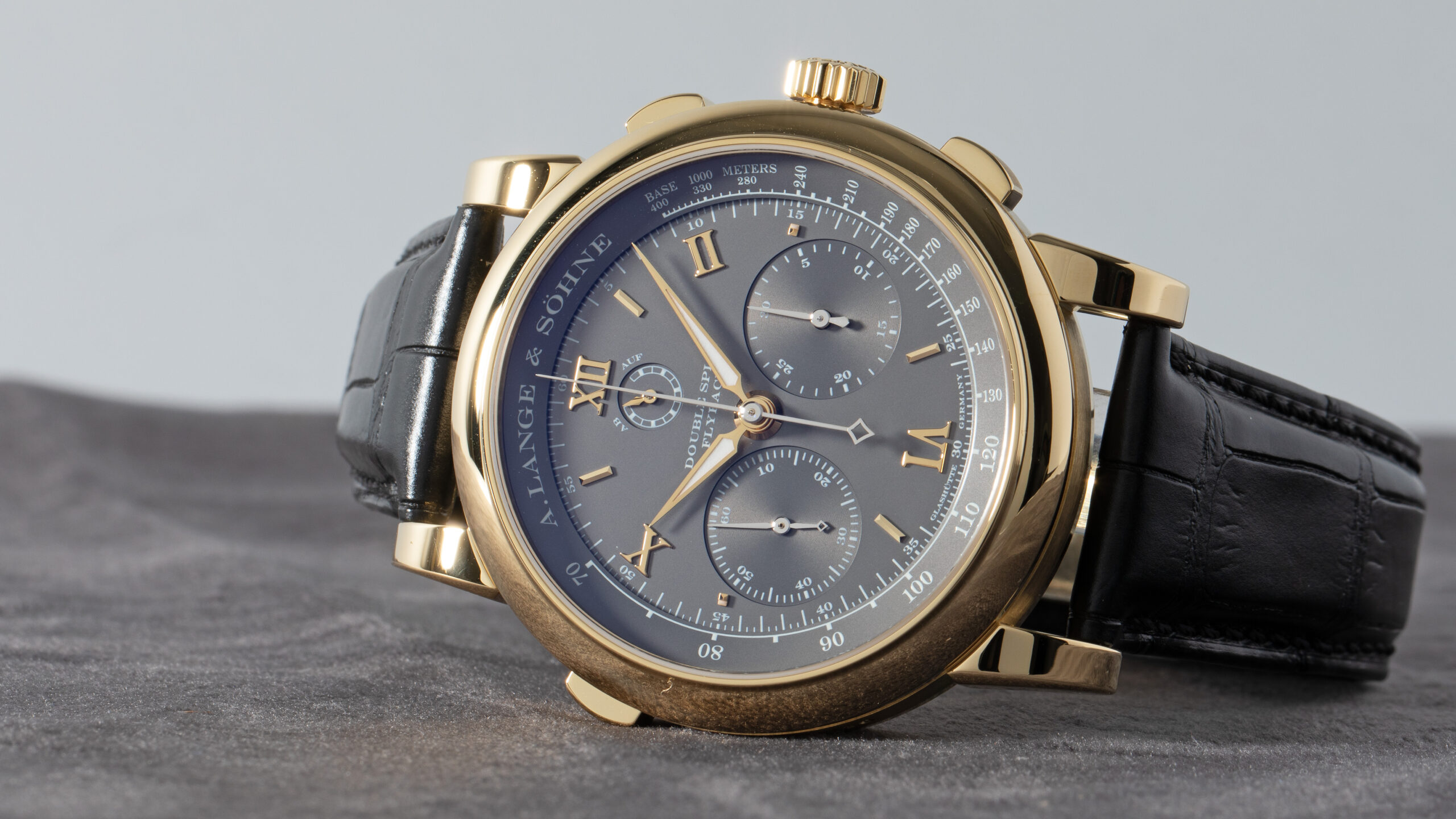
A recently sourced and sold one of 10 Double Split “Japan” Edition. Now with a great friend.
A. Lange & Söhne introduced the Double Split in 2004. It is the world’s first double rattrapante chronograph; which means, in addition to the traditional split-seconds, it is a split-minutes chronograph. Both pairs of hands can be stopped separately and the stopped hands can catch the running hands with a push. This unprecedented mechanical marvel came from a 15 years old start-up brand and was a clear message on what A. Lange & Söhne represents.
The Case for A. Lange & Söhne Double Split
The Double Split has earned A. Lange & Söhne watches the nickname “hockey pucks” among watch enthusiasts—and with good reason. Measuring 43.2 mm in diameter and 15.3 mm thick, its signature solid and dense construction, paired with an industrial-driven design and platinum case, fully justifies this moniker.
The watch’s design balances utility with boldness. The lugs are short yet thick, complementing its robust build. A soft strap rather than an alligator should be used to secure the Double Split on the wrist, to prevent wobbling, which the short lugs help tremendously. The concave bezel seamlessly transitions into the tachymeter scale ring, creating a sense of continuity. The case back features Lange’s characteristic stepped construction, a clever design trick often employed to visually lighten thick watches.
The Double Split is not the most comfortable watch to wear, particularly for extended periods, and it almost demands the use of a deployant buckle. However, for those who appreciate a watch with undeniable presence, few options rival its commanding stature and tempting allure.
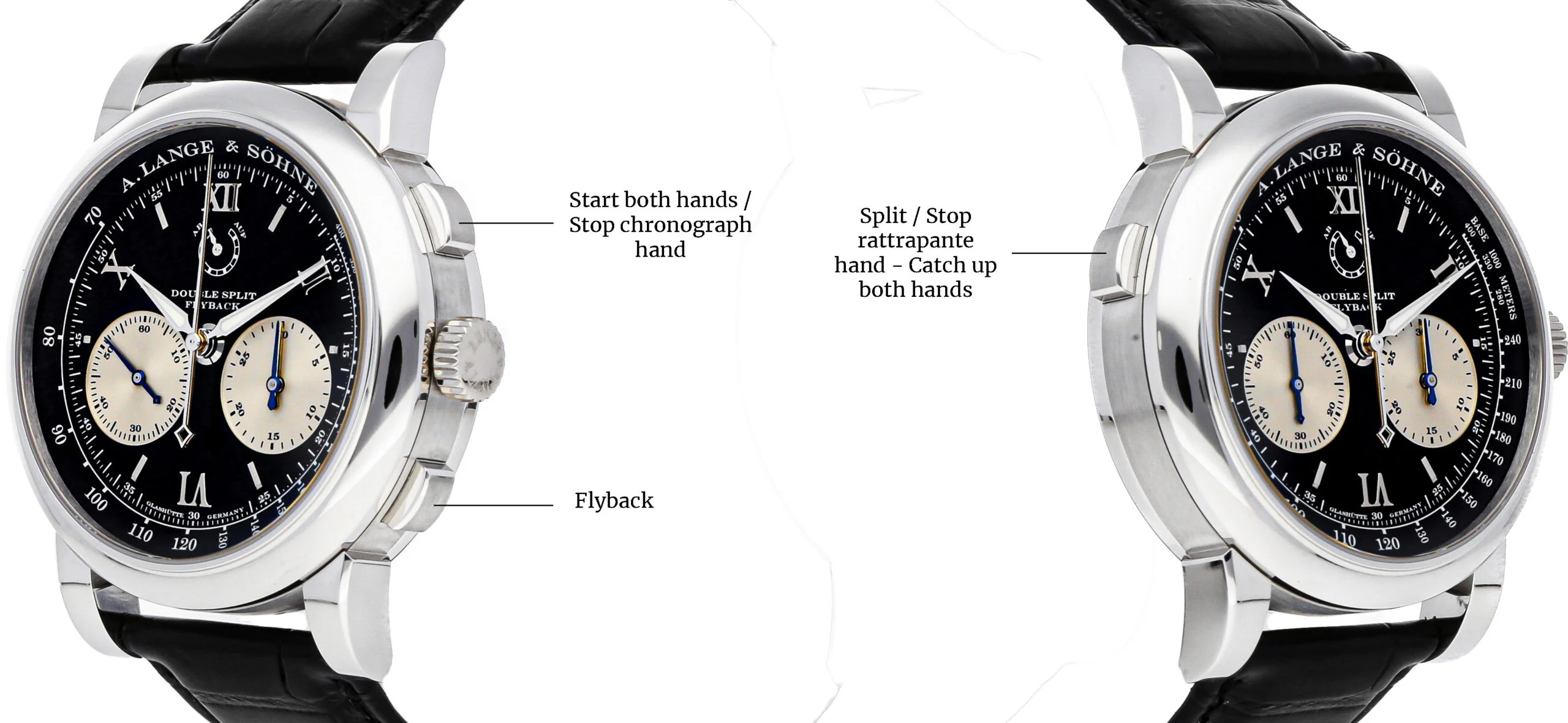
The rather hockey puckish case of the Double Split 404.035. Photos courtesy of The 1916 Company.
All in all, it’s safe to say the Double Split’s case is a masterclass in engineering, undoubtedly meeting Blümlein’s famous mandate: “I want the owner to get the feeling of closing the door of a Mercedes.” It also echoes Walt Odets’ memorable observation about the Saxonia: “It is a watch that only an engineer could love.” The soldered lugs, with their tactile solidity rather than fluid elegance, amplify the watch’s masculinity and rugged character.
Every detail of the case is thoughtfully executed, revealing itself even from the narrowest angles. The interplay between brushed and polished surfaces creates a striking contrast that flows seamlessly through the band, contributing to a case design as visually stunning as it is physically substantial.
Unlike most other watches in A. Lange & Söhne’s lineup, the Double Split’s case back features relief engraving. This detail not only enhances the sense of depth but also perfectly complements the watch’s over-engineered aesthetic, reinforcing its reputation.
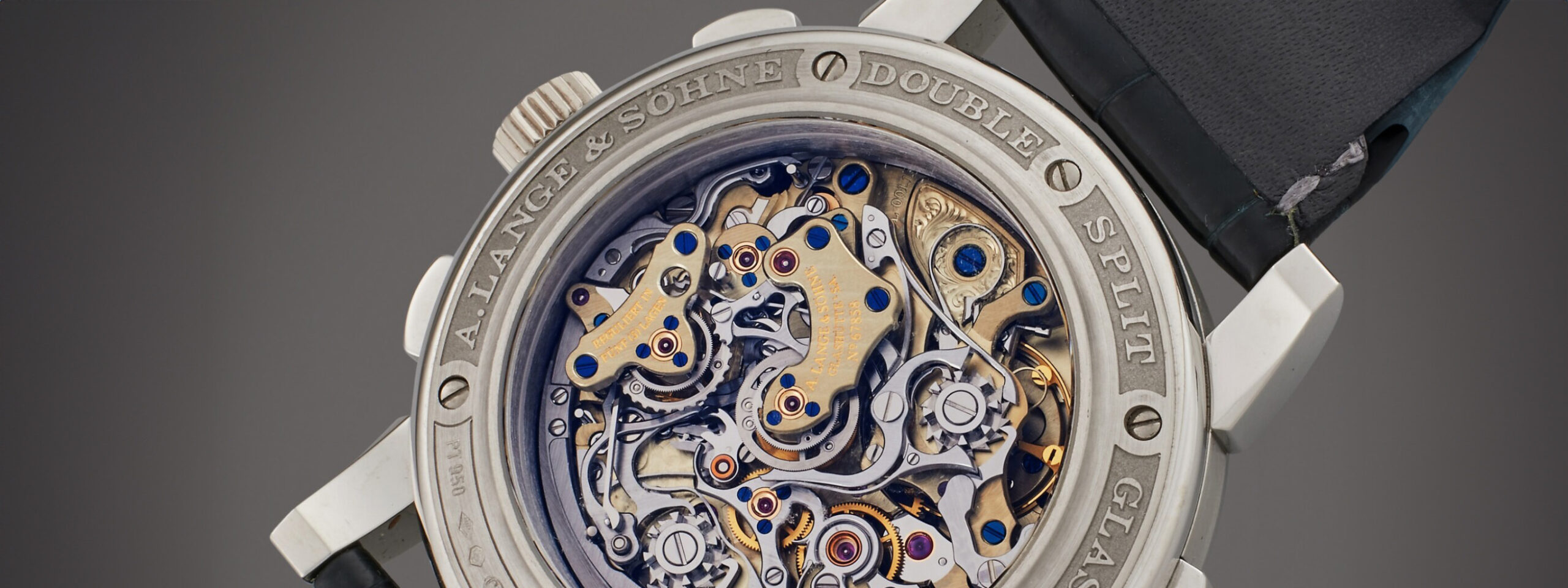
To quantify all this grandeur: the Lange Double Split features a lug width of 22 mm and a buckle measuring 18 mm. Impressively, it weighs approximately 200 grams—even without a bracelet—making it a true heavyweight both literally and figuratively in the world of horology.
A Dial Deep as the Movement
The first lies in the constraints of the base movement (more on that below). The second is a strategic decision by A. Lange & Söhne to leverage the existing prestige of the Datograph. Instead of creating a standalone line, they integrated the development into an already established and celebrated identity. This was not only a practical choice but also a brilliant product launch strategy, ensuring instant recognition and credibility.
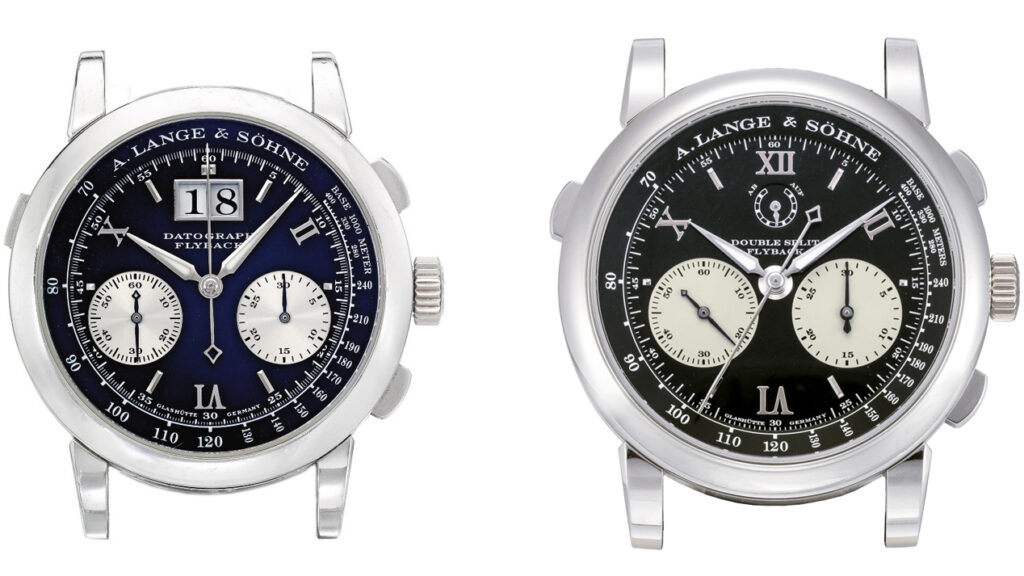
The Datograph measures 39 mm in diameter, while the Double Split expands to 43.2 mm, necessitating adjustments to the dial’s proportions. Notably, the sub-dials on the Double Split are significantly larger than those on the Datograph, effectively reducing the empty space above 6 o’clock. The signature big date of the Datograph is replaced by a highly practical power-reserve indicator at 12 o’clock. This adjustment is complemented by a gold Roman numeral XII, which artfully fills the remaining space and balances the layout with the sub-dials below the center. As with the Datograph, the applied Roman numerals form an equilateral triangle, naturally drawing the eye to a focal point. Perhaps it would be appropriate to summarize it as delightfully busy.
The dial, crafted from galvanized solid silver, is constructed in three distinct steps: the tachymeter scale on the outermost ring, the main dial, and the recessed sub-dials. This layered design mirrors the depth of the movement beneath, creating a harmonious connection between front and back. The Double Split’s black dial is particularly striking—it isn’t enamel or lacquer but possesses a surprising vibrancy.
The “panda” color scheme gives the Mighty Double Split (as coined by Gary Getz) a sporty elegance. This aesthetic is further amplified by broad, lume-filled hands that enhance its dynamic appearance. The interplay of gold and blued steel hands against the deep black background achieves a flawless color harmony while maintaining excellent legibility for the rattrapante operations for you to time who is drinking their beers faster, even under the most dim lights.
Subtle details like the slightly curved hands—not just straight—reward those with a keen eye for craftsmanship, reflecting the meticulous attention to detail that defines A. Lange & Söhne.

As a final note, it’s worth highlighting a rarely known fact: the Double Split (404.035) underwent a subtle facelift between its debut at the 2004 Geneva Watch Salon and its subsequent production release. While the concept was met with immense praise, insiders from the time recall that the initial design wasn’t deemed optimal. Listening to feedback from retailers, Lange made several thoughtful modifications before finalizing the production model.
The changes are easy to spot. The power reserve indicator and tachymeter scale were significantly reworked. The logo was relocated to the tachymeter scale, while the Double Split text within the sub-dial was moved to the center. Additionally, Lange initially attempted to align the beat rate (6 ticks per second) with the hash marks between seconds, but this cluttered the dial. This feature was removed during the redesign, resulting in a cleaner and more cohesive aesthetic.
In my opinion, these adjustments refined the watch’s design, enhancing its balance and legibility, and ultimately delivering a much more accomplished timepiece.
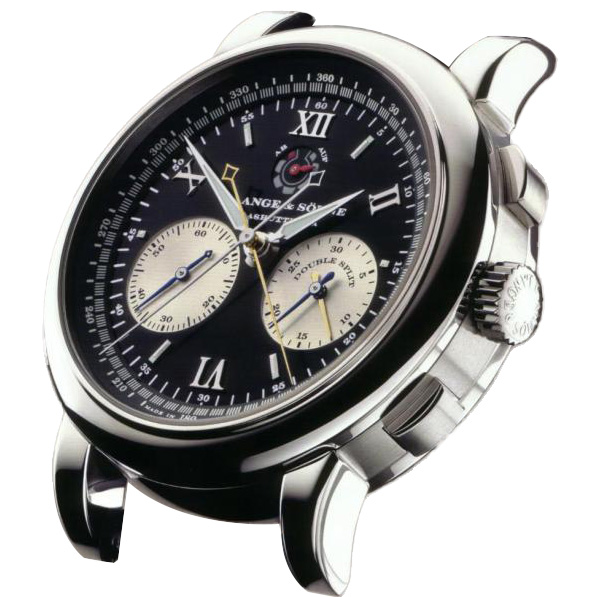
As a final note; rarely known, Double Split (404.035) went through a facelift between its introduction in 2004 during Geneva Watch Salon and later on production. Even though the concept was extremely well received, according to the people who were there at the time, the design was not optimal. Lange collected the feedback of retailers and modified the piece until the production.
Easily noticeable; the power reserve indicator as well as the tachymeter scale was overhauled. The logo was moved to the tachymeter scale and the Double Split within the sub-dial to the center. Moreover, apparently Lange wanted to match the beat rate (6 ticks every second) with the hash marks between seconds and this made the dial a bit crowded; thus removed during the overhaul. In my opinion, it resulted in a much better watch.
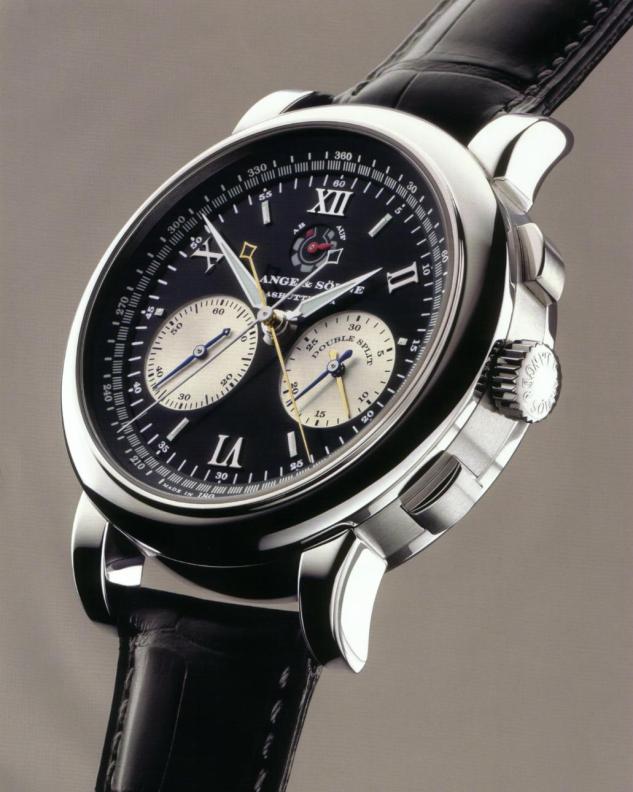
Caliber L001.1
Brace yourself; this is going to be as deep as the movement itself.
As mentioned earlier, the A. Lange & Söhne Double Split is the world’s first double rattrapante chronograph, achieving something unprecedented in watchmaking. While its mechanics are undeniably complex, understanding how it works is a true delight for any enthusiast.
For me, the Double Split’s caliber L001.1 is arguably the most aesthetically captivating, immaculately finished, and mesmerizing movement to observe. It is a harmonious waltz of gracefully curved levers, a stunning palette of metal hues, and masterful craftsmanship. Yes, its thickness is overwhelming to some, but it is precisely this robust architecture that makes it extraordinary. There are plenty of thick movements out there, yet none manage to be as impressive, immersive, or as rich in character as this one.
I would go so far as to call the L001.1 the Michelangelo’s David of mechanical watch movements—a timeless masterpiece that redefines excellence in its field.
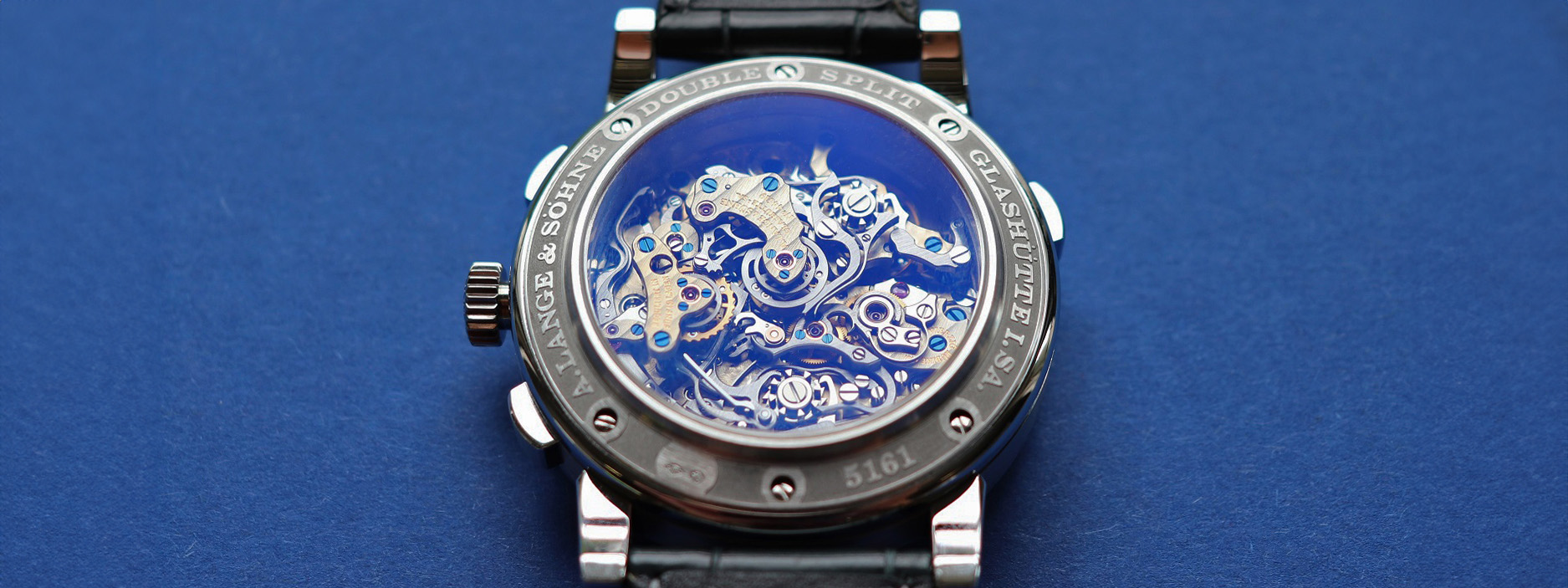
The Double Split’s caliber L001.1 embodies all the hallmarks of A. Lange & Söhne and Glashütte watchmaking traditions, including the hand-engraved balance cock, gold chatons, and blued screws, complemented by a myriad of finishing techniques. The interplay between straight-grained chronograph levers, the flat-polished column wheel, and chamfered edges is nothing short of remarkable. It is, quite simply, a mechanical sculpture—an intricate work of art in every sense.
While the modular construction obscures the view of the balance wheel and its hand-engraved balance cock, this trade-off is more than worthwhile. It allows full exposure to hundreds of moving parts, each performing its role in perfect synchronization—a spectacle of mechanical harmony that few movements can rival.
The caliber L001.1 measures 30.5 mm in diameter and 9.5 mm in thickness. It beats at a traditional 3 Hz (21,600 vibrations per hour) and offers a power reserve of 38 hours. Additionally, it proudly features A. Lange & Söhne’s first-ever in-house balance spring, a testament to the brand’s commitment to advancing its technical and artisanal mastery.
Die Technik – How It Works?
The operation of A. Lange & Söhne’s Double Split begins with a press of the pusher at 2 o’clock. This action starts both chronograph hands simultaneously. While the chronograph is running, pressing the pusher at 10 o’clock splits the chronograph seconds and minute hands, halting the silver hand (and blued minute hand) while the gold hand continues its timing. Pressing the 10 o’clock pusher again allows the silver hand and the blued minute hand to “catch up” with the gold hand, ready for a new measurement. The pusher at 4 o’clock is reserved for the flyback or reset function. Consequently, when operating this marvel of engineering, most of the interaction revolves around the pushers at 2 and 10 o’clock.
The caliber L001.1, the engine behind A. Lange & Söhne Double Split, was conceived in 2001, following the success of the Datograph, one of the final movements initiated while Blümlein was still at the helm. Its construction is modular, comprising three distinct layers:
Gear Train (Base Layer): Located beneath the three-quarter plate, this layer contains the fundamental mechanics for power transmission and timekeeping.
Chronograph Mechanism (Middle Layer): The heart of the chronograph function, this section manages the coordination and operation of the main timing hands.
Double Rattrapante (Top Layer): The crowning achievement of the movement, this layer houses the additional split-seconds functionality. It is instantly recognizable by the so-called twin towers, the components that drive the double rattrapante system.
To fully grasp how the Double Split works, one must first understand the foundational principles of the chronograph. Only then can the complexity of this groundbreaking mechanism—capable of measuring split times not only for seconds but also for minutes—be truly appreciated.
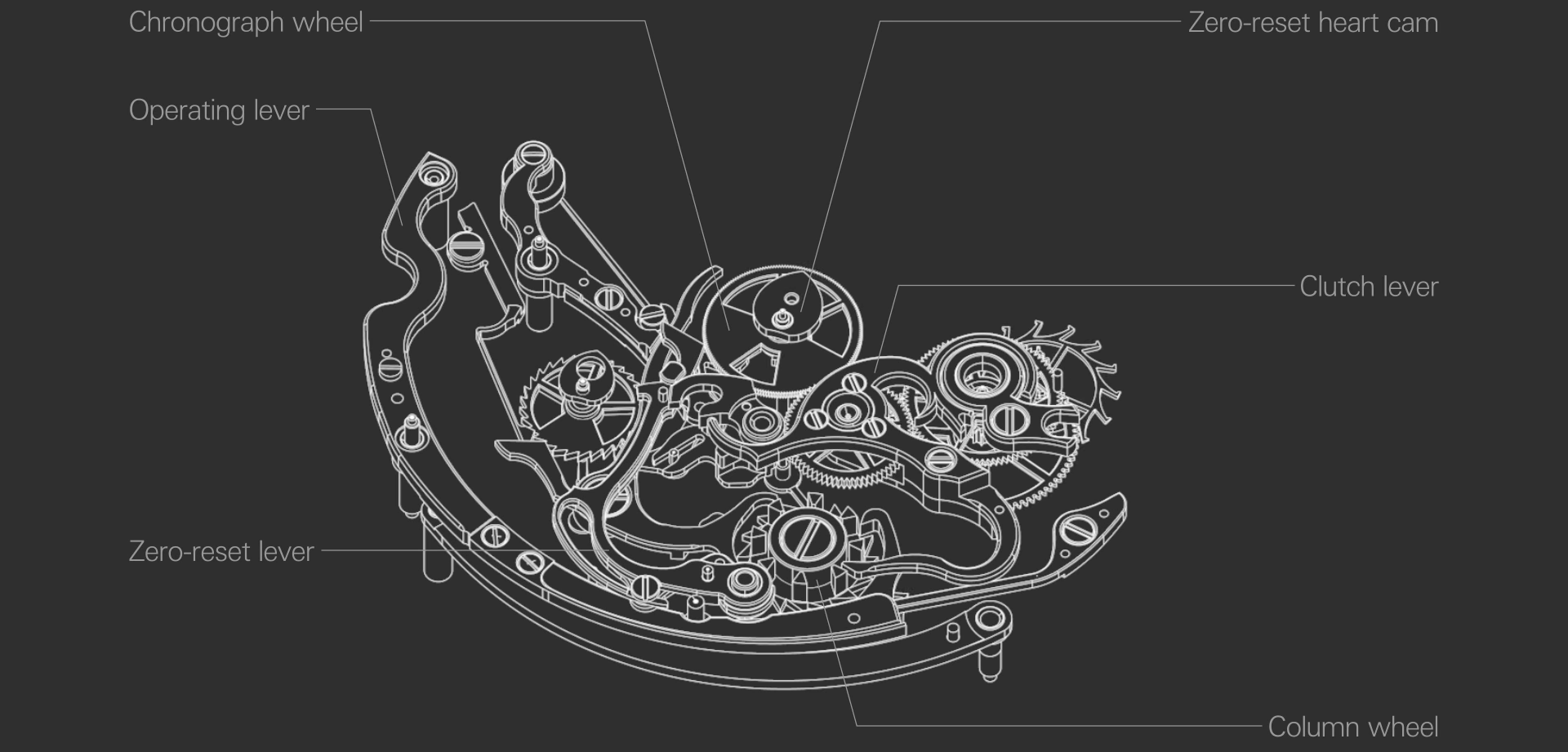
Figure showcasing the chronograph works of the caliber L951 – which is also the middle layer for the L001.1. Courtesy of Lange Uhren GmbH
The column wheel serves as the “processor” of the chronograph, acting as the critical link between the pushers and the functions they activate. If you examine it closely, you’ll notice that key components like the clutch lever, zero-reset lever, and operating lever are all connected to this wheel
Starting the Chronograph:
When the user presses the start button, the column wheel rotates forward, pushing the tail of the clutch lever between its pillars. This motion causes the clutch lever to move horizontally, engaging with the chronograph wheel. This connection allows the chronograph hands to begin timing.Stopping the Chronograph:
Pressing the button again disengages the mechanism. The clutch lever repositions itself onto a pillar of the column wheel, breaking the connection with the chronograph wheel and stopping the hands.Flyback Functionality:
The flyback lever operates on a similar principle. A heart-shaped lever presses against a claw-shaped flyback lever, which interacts with the heart cam on the chronograph seconds wheel. When the flyback function is activated, this mechanism forces the chronograph hands to stop (as long as you hold it) and return instantly to zero, ready to restart. upon release.
Double Split does everything here, twice.
For the diagrams below, I thank to Lange Uhren GmbH for supplying them.
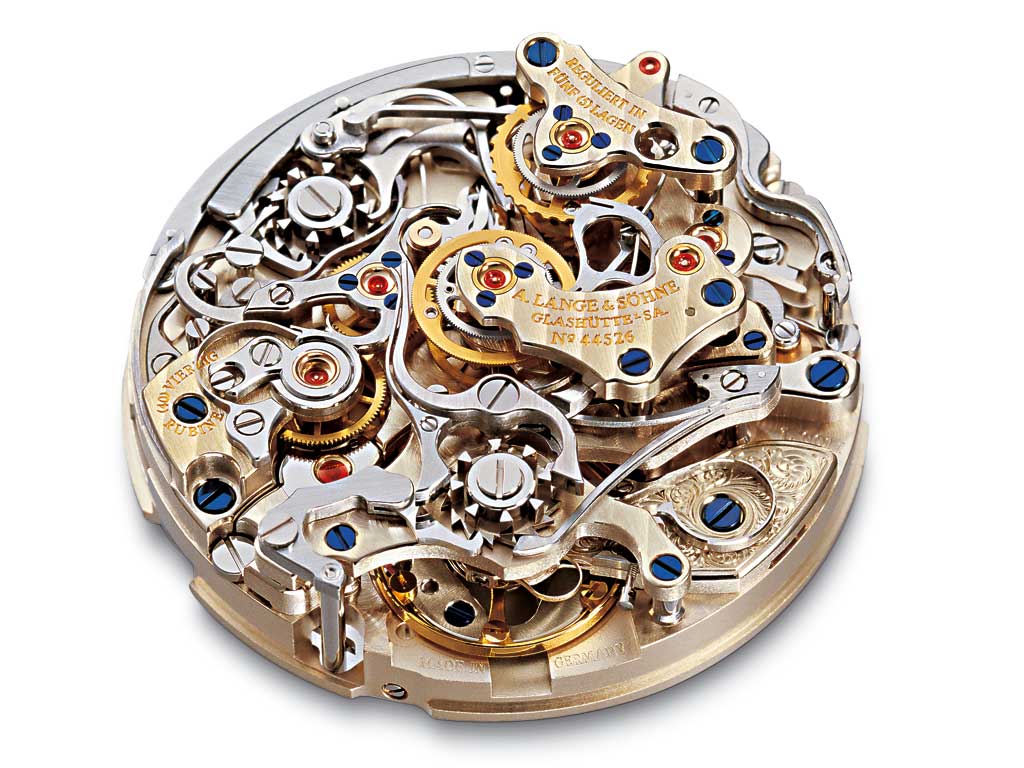
The bridge at 1 o’clock is for rattrapante minutes and the one in the center is for rattrapante seconds. A rattrapante chronograph has two hands that sit on interlocking shafts. In the case of the double rattrapante mechanism, this arrangement exists twice: two seconds hand and two minutes hand. These two shafts rotate together.
Simply put, when you activate the rattrapante while the chronograph is running, you actually halt the rattrapante gear train, allowing only the chronograph hand to run.
Another push catches up (translation of Rattrapante from French) the hands, just like the flyback function mentioned above, the rattrapante wheel spins to rejoice the main chronograph hand and sits on top of it.
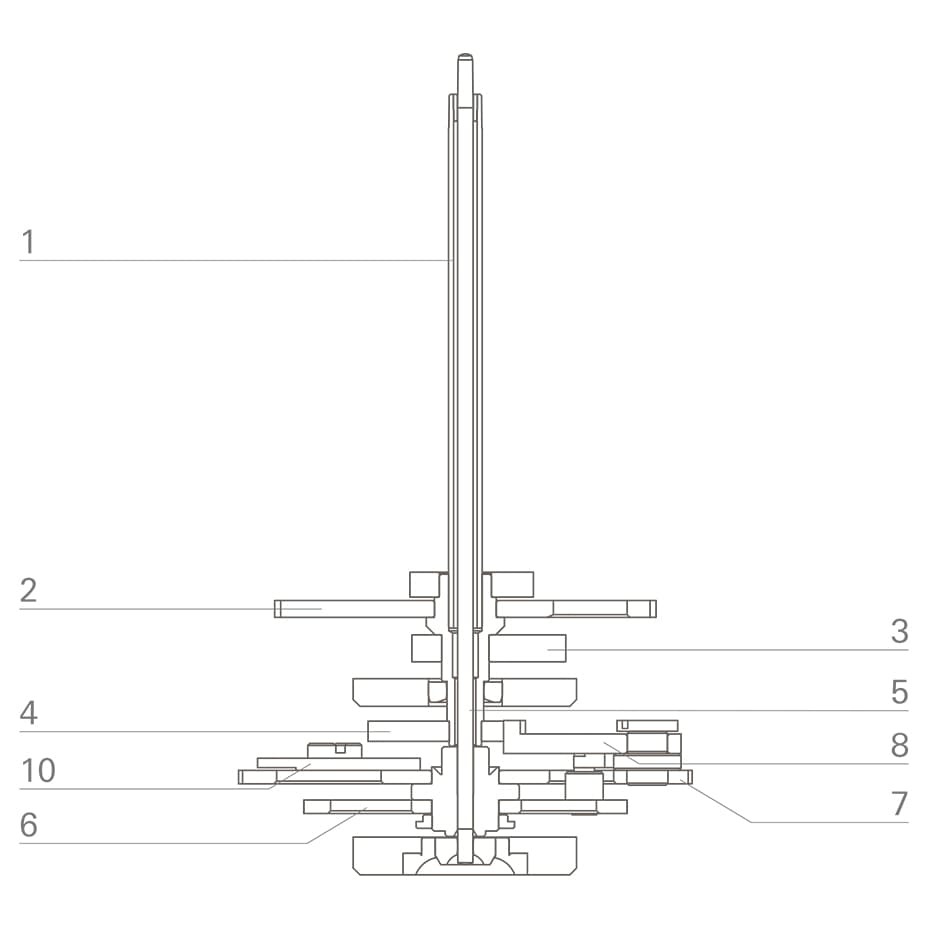
Vertical Section of the Chronograph Seconds’ Shaft
The hollow chrono centre arbor on the outside (1) carries the chrono sweep-seconds hand. It is driven by the chronograph centre wheel (2 – the same wheel at the l951.1 diagram two above). It is rigidly connected to the zero-reset heart cam (3 – also in the l951.1 diagram) of the chronograph centre wheel and the heart cam (4) of the rattrapante center wheel.The heart cam makes it possible to reset the hand to zero by taking the shortest route possible (left or right) – or as the case with rattrapante, to synchronize it with the chronograph sweep-seconds hand.
The rattrapante hand, which is superimposed on the chrono sweep-seconds hand, is attached to the inner rattrapante centre harbor (5). This arbor holds the disengagement wheel (6) and the rattrapante centre wheel (7) to which the rattrapante heart lever (8) is attached. (Figure 2)
These are incredibly thin, very hard to manufacture parts and the arrangement of tolerances and assembly is completely depending on the mastery of the watchmaker. Truly, a mondboggling work.
Starting and stopping the Lange Double Split:
In the basic position, the rattrapante heart lever (8) is pressed against the flat side of the heart cam (4) of the rattrapante wheel via a spring (9). This connects the otherwise separately movable chrono centre arbor (1) and the rattrapante center arbor (5). So that when the chronograph hand starts to move, rattrapante moves as well.

When the rattrapante pusher is activated, the column wheel (11) rotates one step. Now, the split-seconds clamp (12) closes and arrests the rattrapante centre wheel (7). An arresting spring (13) concurrently seizes and stops the rattrapante minute counter while the two chronograph hands (seconds and minutes) continue to move. When the pusher is pressed again, the rattrapante clamp (12) opens and the minute arresting spring (13) is pushed aside. Thus, the rattrapante hand instantly joins the running chronograph hands.
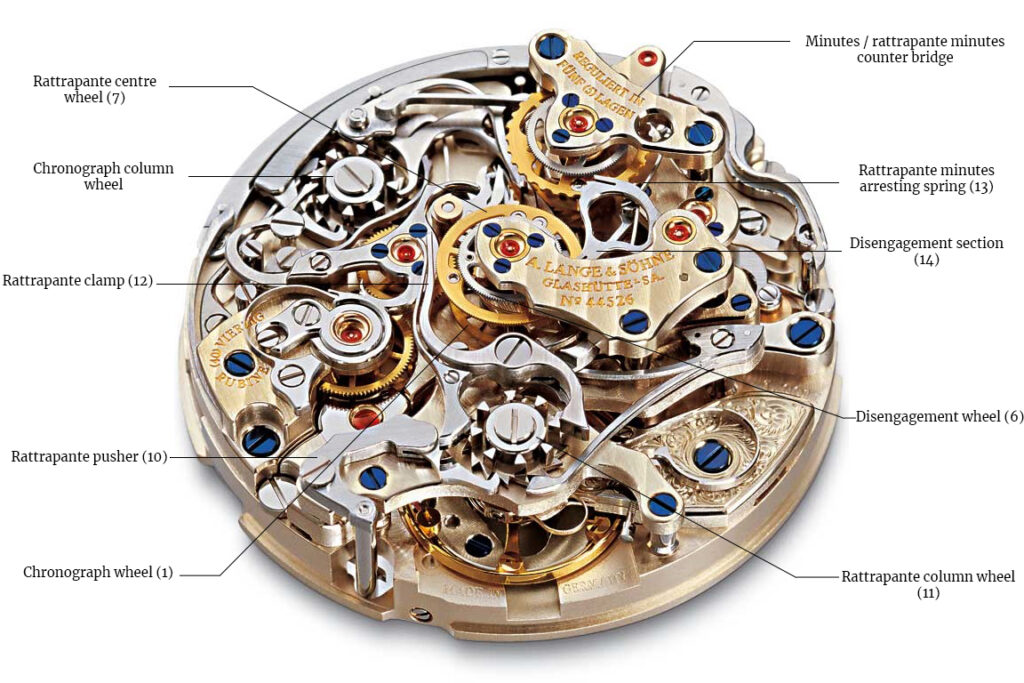
In addition, Double and Triple Split boasts a patented “disengagement mechanism”. A. Lange & Söhne describes the system as follows:
In the regular rattrapante mechanisms such as Tourbograph or 1815 Rattrapante Perpetual Calendar, as the chronograph hands continue to run while the rattrapante hands are stopped, the rattrapante heart lever (8) would rub against the rattrapante heart cam (4) of the rattrapante center wheel, which continues to run along with the chrono centre arbor (1). This in return causes friction therefore loss of amplitude. (Figure 3)
For the Double Split, actuating the pusher (10) also pivots the disengagement segment (14) inward. This motion rotates the disengagement wheel (6) by about 20 degrees in the other direction. The bottom side of the wheel carries a pin that when rotated in the opposite direction swings the rattrapante heart lever (8) out of the engagement zone of the heart cam (4) of the rattrapante center wheel thus the chronograph runs smoothly.
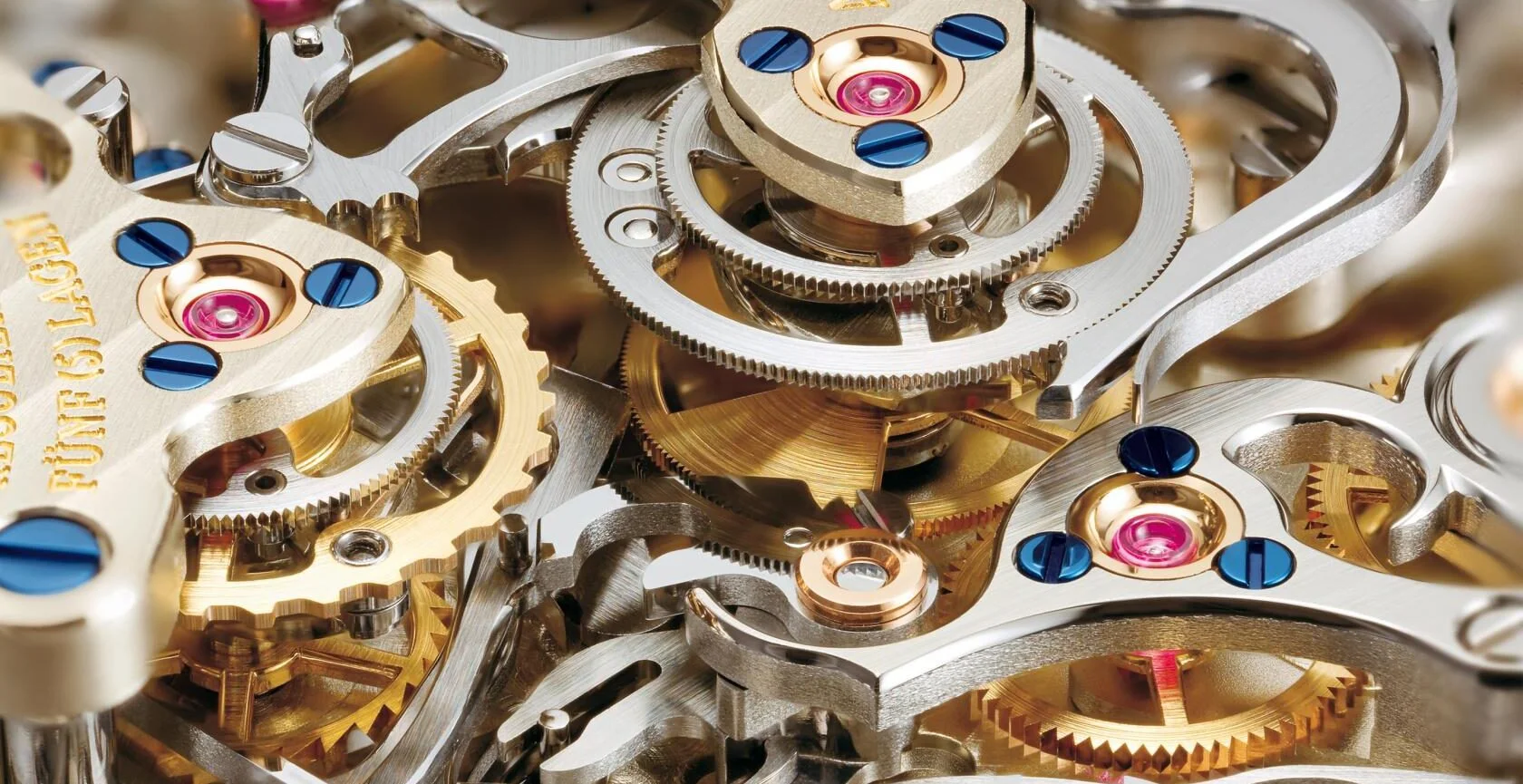
Disengagement wheel (top) in between the rattrapante clamps, rattrapante wheel (middle, silver color), and chronograph wheel (bottom, golden color). Courtesy of Lange Uhren GmbH
On top of all these mind boggling engineering, Double Split features a flyback system and a precisely jumping minute counter.
Today, we have incredible concepts of advanced chronographs. From Jaeger-LeCoultre’s Duometre to MB&F’s Sequential Evo, there are a myriad of choices. Though I cannot help to think that Double Split is the one who paved the way for others to shine. And even today, A. Lange & Söhne holds its ground with a marvel like Triple Split.
PS: The disengagement mechanism is not exclusive to A. Lange & Söhne. Patek Philippe also has a brilliant example on their caliber CHR 29-535 PS
Double Split - Pink Gold (2010)
Following 6 successful years, A. Lange & Söhne discontinued the legendary platinum Double Split reference 404.035 and introduced the facelifted pink gold version in 2010.
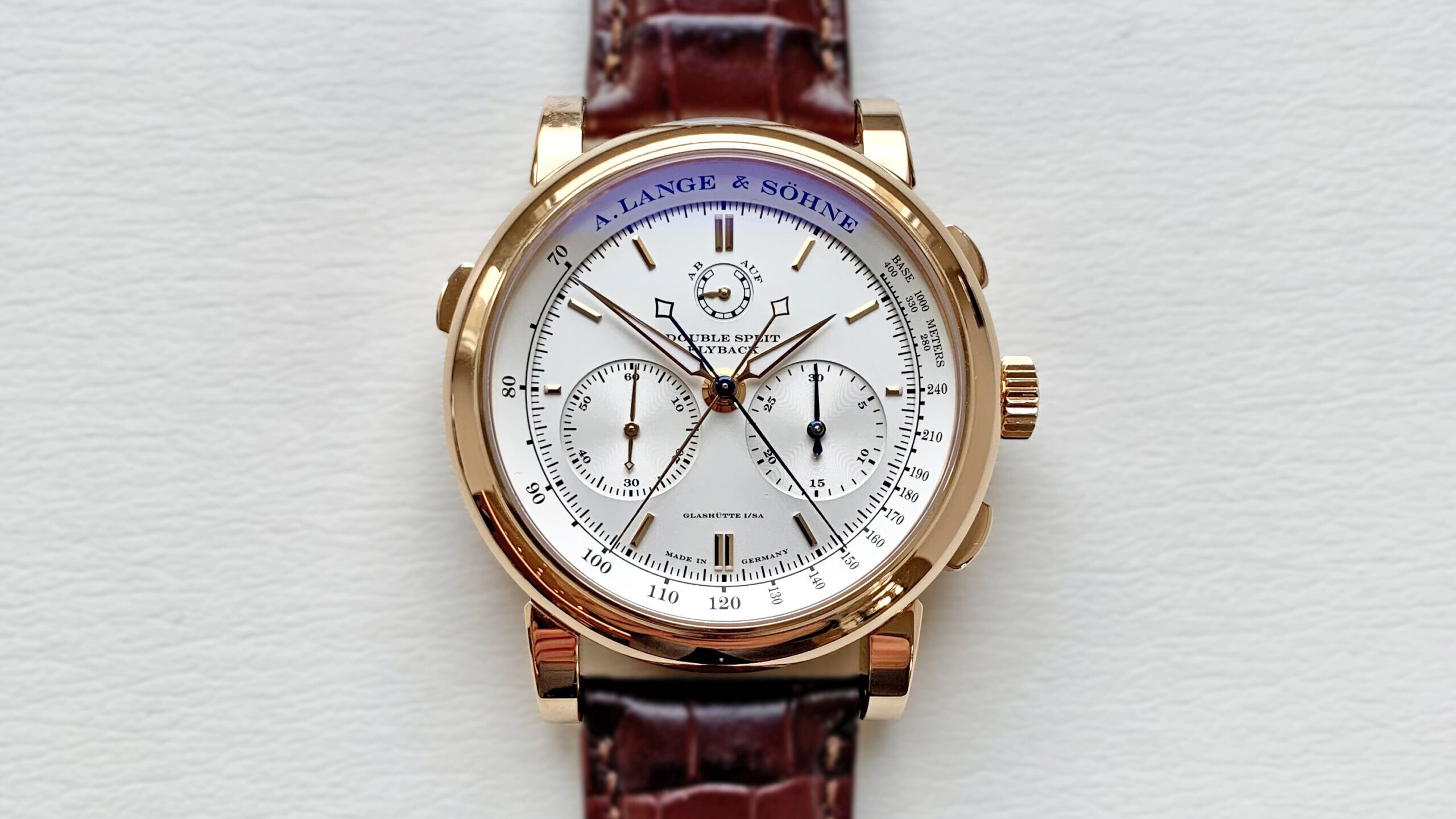
As noted in the Datograph Up/Down article, the late 2000s and early 2010s marked a significant period of transition for A. Lange & Söhne, coinciding with a shift in management. This change ushered in a noticeable evolution in the brand’s design language. Moving away from its more baroque influences, Lange adopted cleaner lines, eliminated Roman numerals, “M”-shaped hash marks, and other classical elements in an effort to modernize its aesthetic.
For example, alongside updates to the Double Split, the brand reimagined the 1815 Chronograph and the Datograph Perpetual. The Double Split lost its Roman numerals (a change mirrored by the Datograph in 2012), and the 1815 Chronograph abandoned its vintage pulsometer scale. While these adjustments introduced a cleaner, more contemporary appearance, they also diluted some of the bold character that defined these earlier models. The pieces remain beautiful, but they lack the striking presence of their predecessors. The second-generation Lange Double Split, for instance, feels more romantic in its execution—an unexpected shift for a watch that thrives on its mechanical assertiveness and industrial façade.
One notable design change in the A. Lange & Söhne’s Double Split reference 404.032 is its fully polished pink gold case, in contrast to the alternating finishes of the 404.035 in platinum. The loss of the stark distinction between the polished case and brushed lugs results in a calmer, less aggressive look. While this would have been disappointing for the platinum variant, the polished case suits the more restrained and refined nature of the pink gold reference, complementing its already simplified design.
Despite the aesthetic changes, the case dimensions and mechanical specifications of the Double Split remained unchanged. It is still the same beast, albeit now with a gentler visual impression.
A. Lange & Söhne discontinued the production of the platinum Double Split in 2011, whereas the pink gold edition continued until 2017 – a year before the introduction of the Triple Split.
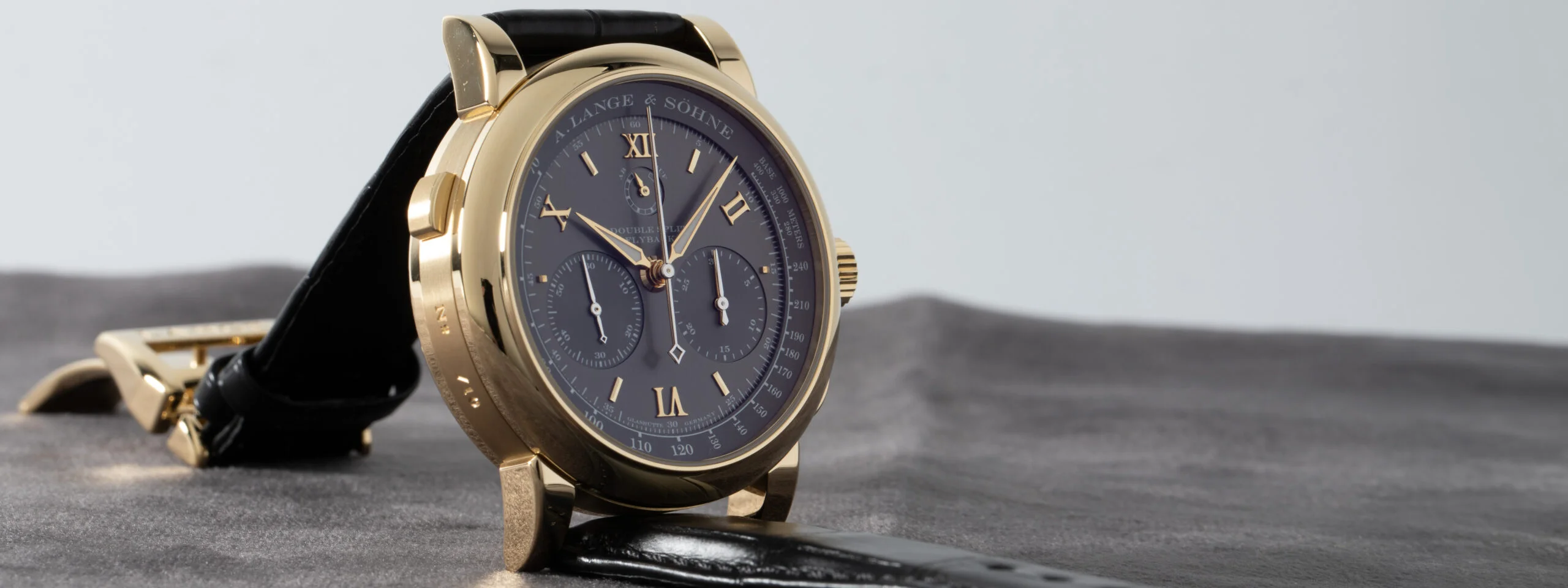
Sourced and sold at Langepedia x The 1916 Company Marketplace. Double Split Japan Edition.
Buying a Double Split
When A. Lange & Söhne Double Split reference 404.035 was introduced in 2004, its retail price was set at $97,000. Over the next six years, this price saw an increase of approximately 30%, reaching $126,800 by the time the model was discontinued. Pricing a watch of such innovative engineering is inherently challenging, but the figure becomes more justifiable when compared to its competitors at the time. Unfortunately, this pricing trajectory was not mirrored in the pre-owned market.
It was an overall A. Lange & Söhne trend, but the primary reason for this limited demand, in my opinion, lies in the watch’s lack of wearability. The Double Split is not the easiest watch to wear due to its substantial size and weight. Most collectors I’ve known tend to acquire this extraordinary piece for its engineering brilliance and as a display item rather than something to regularly wear. This significantly reduces the potential market size, and consequently, the resale value. In some ways, it parallels the A. Lange & Söhne Grand Complication, which, at 50 mm in diameter and 20 mm thick, is more of a mechanical thirst than a practical wristwatch.
Over the years, the pre-owned market price for the platinum Double Split has remained stable in the range of $60,000–$70,000. However, with the rising tide during Covid and thereafter the prices for early A. Lange & Söhne pieces, including the Double Split, began to rise gradually. By June 2022, the platinum Double Split had surpassed the $100,000 mark in listings. In my humble opinion, given its horological significance, engineering excellence, and timeless design, the Double Split remained a bargain even at these elevated prices.
Following a cooldown within the 2023 and 2024, the Double Split in platinum is now back at the mid $80k range, depending on its set and condition. The pink gold example sees a bit less demand, often 10-15% more approachable than its platinum sibling.
One final note worth mentioning is the existence of a unique stainless steel Double Split, created around 2008 for an A. Lange & Söhne executive. This piece was sold at Christie’s in 2013 for an impressive CHF 461,000. For those intrigued by rare and unique A. Lange & Söhne pieces, this watch—and others like it—are explored in greater depth in the article about stainless steel A. Lange & Söhne watches.
It is rather hard to put a price on special editions of A. Lange & Söhne Double Split – simply because they are done in limited editions of 5 or 10, making rare appearances in the market.
Thank you for diving into this journey through one of the most fascinating horological achievements of our time!
I hope this was a valuable guide for whomever is looking for a Double Split or just want to learn the details and history of these pieces. If you’d like to chat, sell or buy a Double Split, please kindly reach out to me via alp@langepedia.com
Further Reading:
- Collector’s Guide to Datograph
- A Guide to Datograph Perpetual
- Patek Philippe v A. Lange & Söhne Part 1: Chronographs
- An Adage to Datograph Perpetual Tourbillon
- The Collector’s Guide to 1815 Chronograph
- An in-depth Look at the 1815 Chronograph “Boutique Edition”
- An in-depth Look at the 1815 Rattrapante Perpetual Calendar
Please feel free to contact:
Follow Langepedia on Instagram:
Watch “A. Lange Story” Documentary, in partnership with The 1916 Company:
STAY IN TOUCH
Sign up for the newsletter to get to know first about rare pieces at Marketplace and in-depth articles added to the encyclopedia, for you to make the most informed choice, and first access!